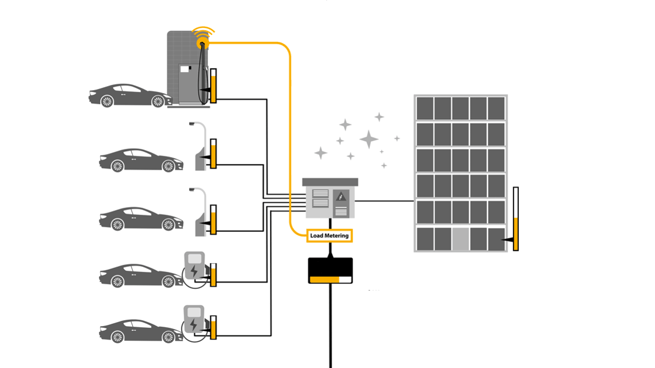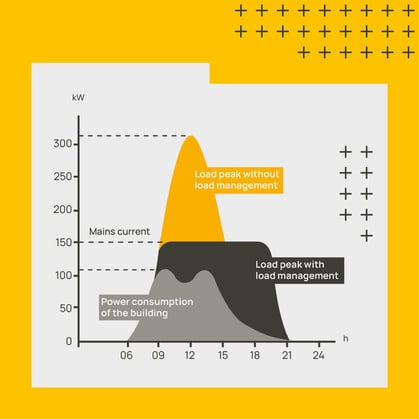Dynamic Load Management
In an increasingly electrified world, the expansion of the charging infrastructure in Germany for electric vehicles (EVs) is becoming more and more important. According to statista a total of 470,599 all-electric cars were registered in 2022 alone. A year earlier, 355,961 new registrations had already been registered. As recently as July 2023, the Ministry of Economics increased the budget for the electric car premium again and further increased the funding pot for electric mobility. But as the number of electric cars on the road increases, the importance of an efficient and reliable power supply and the rapid expansion of private and public charging infrastructure is becoming increasingly clear.
To achieve this goal, many operators of charging parks rely on charging stations with integrated dynamic load management. Dynamic load management is an innovative approach to optimising energy distribution when charging electric cars. Because without sensible energy distribution during charging, your car may either not be charged at all or too little. With the consequence: the car stops and you have the frustration. In this blog post we will give you an overview of the following topics:
- Advantages and disadvantages of dynamic load management
- The differences to static load management
- The status quo of the charging infrastructure in Germany
- A glimpse into the future
What is dynamic load management?
In electromobility, the intelligence of a charging station is largely determined by the charge controller used. The charge controller is the heart and brain of a charging system and it can have several built-in features. The integration of dynamic load management is also possible. Dynamic load management is responsible, among other things, for controlling the flow of energy in an electricity grid and distributing the electricity to the different consumers. It is based on real-time monitoring of the energy supply to optimally distribute power consumption. In the context of electric mobility, this means that the charging processes of electric vehicles are coordinated in such a way that they minimise the load on the power grid and make optimal use of the existing grid infrastructure. And the best part: no car remains empty.
How it works
The way dynamic load management works is based on communication between the power, the local installed charging infrastructure and the electric vehicles at a location. The power grid monitors the current energy demand and the available grid capacity. The charging infrastructures, such as charging stations, are connected to the power and receive information about the current load on the grid. When an electric vehicle needs to be charged, it communicates with the charging infrastructure to communicate its need for charging. The charging infrastructure, in turn, communicates with the power grid to determine the availability of energy and the best times for charging.

Dynamic load management takes various factors into account when allocating charging processes and is virtually multitasking. These include the grid load, the availability of renewable energy sources, the tariff structure and the individual preferences of vehicle owners. Based on this information, the optimal time for charging is determined in order to avoid bottlenecks in the grid and minimise electricity costs.
Advantages of dynamic load management
- Optimal utilisation of network capacity: dynamic load management enables efficient distribution of electrical loads and ensures that the existing grid infrastructure is not overloaded. Through the intelligent control of charging processes, the grid can be kept stable even if a high number of electric vehicles are being charged at the same time.
- Reduction of grid expansion costs: By avoiding overloads in the grid, dynamic load management can help to avoid expensive grid expansion measures. It optimises the use of the existing infrastructure and thus enables a cost-efficient scaling of the charging infrastructure.
- Flexibility and adaptability: Dynamic load management offers the possibility to adapt energy consumption to changing conditions. It can react to peak load times by reducing or postponing the charging power. This can avoid bottlenecks and ensure optimal distribution of energy.
Disadvantages of dynamic load management
- Complexity and infrastructure requirements: The implementation of dynamic load management requires comprehensive monitoring and control of the energy supply. This requires advanced infrastructure, such as smart measuring systems and communication networks that enable real-time transmission. The complexity and cost of setting up such systems can be challenging.
- Communication dependency: Dynamic load management is based on effective communication between the electric vehicles and the power grid. Disturbances or failures in communication can impair the effectiveness of load management. A reliable and secure communication infrastructure is therefore crucial.
Differences to static load management
In addition to dynamic load management, there are other load management systems. One of the most widespread is the so-called static load management. In contrast to dynamic load management, static load management is based on fixed rules and schedules. It does not take into account real-time data and does not adapt to current conditions. Static load management may be easier and cheaper to implement, but it does not offer the flexibility and efficiency of dynamic load management. It is not able to react to unforeseen events and optimally distribute the load on the power grid.
The challenge of peak loads
The expected increase in electric cars on German roads will, among other things, lead to the possibility of load peaks, which may result in an overload or even a collapse of the power grid. Peak loads are the times of day when demand for electricity is highest. This is usually in the early evening when people come home from work and switch on lights and appliances. Reasons for peak loads include the fact that electric vehicles are often not the only energy consumers at a location. In addition, there are often no additional power connections planned or available at a site due to construction work or the grid operator. An expansion would cause new costs for the operator. In addition, it is often not known how much electricity is still available from existing house connections at what point in time. In order to optimally distribute the required power, so-called load management is used.
 With the help of electricity storage and load management, peak loads can be avoided. Load management is the control of electricity demand through the targeted switching on or off or regulation of electricity consumers.
With the help of electricity storage and load management, peak loads can be avoided. Load management is the control of electricity demand through the targeted switching on or off or regulation of electricity consumers.
Bidirectional charging – ready for the future
Bidirectional charging – ready for the future
Dynamic load management becomes really exciting with the possibility of bidirectional charging. Bidirectional charging is an innovative technology that gives electric vehicles a significant role in future energy supply. Unlike conventional charging systems that only enable charging, bidirectional charging allows electric cars to both absorb energy from the grid and release it back into the grid.
How does it work? Modern electric cars are equipped with a bidirectional charging system that enables them to function as mobile energy storage units. During the charging process, the battery of the electric vehicle is charged with energy from the power grid so that the vehicle can continue to drive. But bidirectional charging goes beyond that: When the electric car is parked or not in use, it can release excess energy from its battery back into the grid.
This functionality opens up a multitude of advantages. Firstly, it allows electric cars to serve as an additional source of energy for the power grid during periods of high demand. In the event of bottlenecks, bidirectional charging can support grid capacity and thus stabilise the power grid. Secondly, it can contribute to the integration of renewable energies by storing surplus solar or wind energy and feeding it back into the grid when needed.
In addition, bidirectional charging opens up new business opportunities. Electric car owners, for example, can sell surplus energy from their vehicles to the grid and thus generate an additional income stream. Companies could integrate electric vehicles as mobile energy storage units into their energy supply strategy and thus improve their flexibility and sustainability.
Overall, bidirectional charging offers a promising solution to the challenges of the energy transition. It enables better integration of electric vehicles into the power grid and creates new opportunities for a sustainable and smart energy future.
Outlook on charging infrastructure in Germany
The charging infrastructure in Germany has made considerable progress in recent years. The promotion of electromobility and the increasing number of electric vehicles have led to an increased demand for efficient energy distribution. Dynamic load management offers a promising solution to address the challenges of charging infrastructure. By making optimal use of grid capacity, reducing grid expansion costs and providing flexibility in adapting to changing conditions, dynamic load management can contribute to a sustainable and efficient charging infrastructure.
However, there are still some challenges to overcome. A comprehensive infrastructure and reliable communication networks are required to successfully implement dynamic load management. Collaboration between energy supply companies, vehicle manufacturers, grid operators and regulators is essential to ensure interoperability and standardisation.
Overall, dynamic load management is an important step on the way to sustainable mobility and efficient use of renewable energies. As charging infrastructure continues to develop and technology advances, we can expect a promising future where electric vehicles are seamlessly integrated into the electricity grid and contribute to the decarbonisation of our transport system.



